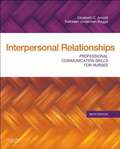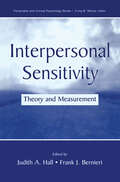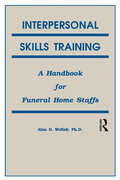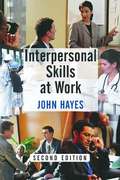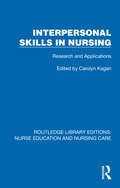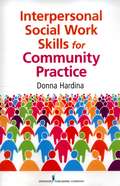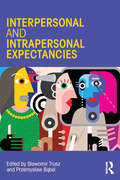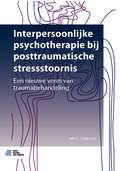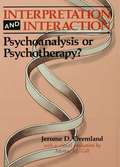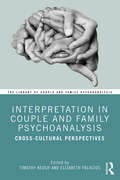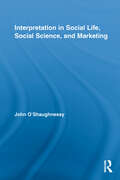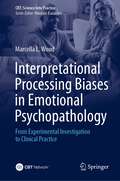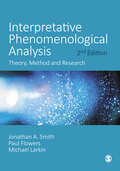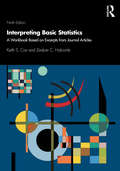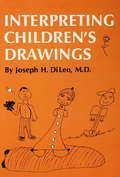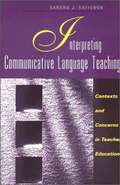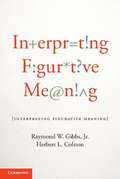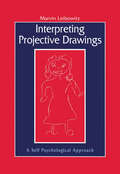- Table View
- List View
Interpersonal Relationships: Professional Communication Skills for Nurses
by Kathleen Underman Boggs Elizabeth C. ArnoldAcclaimed for its strong theoretical framework and consistent organization, Arnold and Boggs' Interpersonal Relationships: Professional Communication Skills for Nurses, 6th Edition, remains the definitive resource in developing effective communication with clients, families, and colleagues in order to achieve treatment goals in health care. This two-time AJN Book of the Year award-winner is thoroughly updated and includes current references describing how to modify communications strategies for various populations and situations including children, the elderly, end of life, health teaching, stress, crisis, and colleagues. Two new chapters address issues in contemporary health care related to promoting health safety and supporting continuity of care. Not only does this book present proven communications strategies and principles in nursing, psychology, and related theoretical frameworks, but also it challenges you to apply these strategies and principles to numerous exercises and practical nursing case studies. Written in terms of the nurse-client relationship, the cutting-edge communications strategies presented are key for nursing students and professional nurses. Covers all mandated topics for nursing professionals, from beginning students to staff development in a variety of settings, including professional collaboration, health team communication, patient-centered care, safety, and hand-off communication. Discusses nursing, behavioral, developmental, family, and communication theories, providing an essential foundation and a theoretical perspective of effective communication. Offers basic concepts first, followed by applications with emphasis on assessment, providing a sound framework as you prepare for nurse-client interactions. Experiential exercises offer the opportunity to practice, observe and critically evaluate your professional communication skills in a safe learning environment. Critical Thinking Exercises promote critical thinking processes essential for effective communication in nursing practice. Includes case examples throughout, creating empathy for clients' perspectives and needs. Offers Ethical Dilemma and Developing an Evidence-Based Practice boxes in each chapter. Describes how best to use the electronic health record for clear communication with current information on classification systems, standards of documentation, and telehealth technologies used in nursing. Acknowledges humor, gender, and touch as important means of communication in interpersonal relationships. Increases awareness of the issues involved in communicating with individuals of various stages of life, clients with special needs, and colleagues in all areas of health care. Provides learning objectives, chapter overviews, and a detailed glossary -- all designed to focus your learning and help you organize key content. A timely NEW Communicating for a Safe Environment chapter provides practice guidelines in line with The Joint Commission National Patient Safety Goals on improved communication among caregivers. NEW Communicating for Continuity of Care chapter defines COC and describes current challenges, and addresses its relational, informational, and management dimensions. Enhanced discussion on spirituality and end-of-life needs focuses on trust, empathy, and the nurse-client relationship -- all central components of holistic nursing identified by The Joint Commission as priorities for patient care.
Interpersonal Sensitivity: Theory and Measurement
by Judith A. Hall Frank J. BernieriInterpersonal sensitivity refers to the accuracy and/or appropriateness of perceptions, judgments, and responses we have with respect to one another. It is relevant to nearly all aspects of social relations and has long been studied by social, personality, and clinical psychologists. Until now, however, no systematic or comprehensive treatment of this complex concept has been attempted. In this volume the major theorists and researchers of interpersonal sensitivity describe their approaches both critically and integratively. Specific tests and methods are presented and evaluated. The authors address issues ranging from the practical to the broadly theoretical and discuss future challenges. Topics include sensitivity to deception, emotion, personality, and other personal characteristics; empathy; the status of self-reports; dyadic interaction procedures; lens model approaches; correlational and categorical measurement approaches; thin-slice and variance partitioning methodologies; and others. This volume offers the single most comprehensive treatment to date of this widely acknowledged but often vaguely operationalized and communicated social competency.
Interpersonal Skills In Organizations (Fifth Edition)
by Suzanne C. De Janasz Karen O. Dowd Beth Z. SchneiderInterpersonal Skills in Organizations by de Janasz, Dowd, and Schneider takes a fresh, thoughtful look at the key skills necessary for personal and managerial success in organizations today. Exploding with exercises, cases, and group activities, the book employs an experiential approach suitable for all student audiences. The book is organized into 4 distinct sections (Understanding Yourself, Understanding Others, Understanding Teams, and Leading) that can be used collectively or modularly depending on the instructors' preferences and students' needs. The emphasis in this edition focuses on making the text more current along with making the text pedagogically effective for students and instructors.
Interpersonal Skills Training: A Handbook for Funeral Service Staffs
by Alan WolfeltThis comprehensive handbook provides a solid foundation in helping skills related to successful funeral service practice.
Interpersonal Skills at Work: Goal Directed Behaviour At Work
by John HayesIn this age of e-business, there is an increasing over-reliance on electronic communication and insufficient attention paid to the management of face-to-face relationships. In this fascinating text, John Hayes addresses this significant workplace issue by examining the nature of interpersonal skill: the goal-directed behaviours used in face-to-face interactions in order to achieve desired outcomes. He argues that interpersonal competence is a key managerial skill which can distinguish the successful from the unsuccessful. Providing a clearly structured and comprehensive overview of the interpersonal skills essential for effective functioning at work, this book presents a micro-skills approach to development that can be used to improve interpersonal competence, as well as explaining, through the use of illustrations and practical examples, how to read the actual or potential behaviour of those around us. This knowledge can then be used to guide the way in which we relate to others as we learn to manage our relationships more effectively. This book will be ideal for practising managers and students of business and management studies and psychology. The skills it promotes make it of great value for those in a wide range of professions (including teachers, doctors, nurses, social workers and police officers) in their everyday working environment.
Interpersonal Skills in Nursing: Research and Applications (Routledge Library Editions: Nurse Education and Nursing Care)
by Carolyn KaganOriginally published in 1985, this book locates interpersonal skills in nursing in both social psychological and nursing contexts. It exposes nurses and nurse educators to different strategies for assessing, teaching and evaluating interpersonal skills and examines those aspects of specialised nursing care that raise particular issues in the field of interpersonal skills. The book thus combines reports of specific research studies with practical applications.Aimed at nurse educators ranging from tutors and those involved in training in specific nursing specialities to psychologists the book will be of relevance to advanced students, interested in interpersonal aspects of nursing and to practitioners.
Interpersonal Social Work Skills For Community Practice
by Donna HardinaSpecifically dedicated to the "skills" that social workers need to advance community practice, this creative book is long overdue. Grounded in the wisdom and evidence of well-honed interpersonal social work skills. . . Donna Hardina's new text takes community practice to a higher level than ever before developed in book form; indeed she displays the most thorough understanding of research on community practice that I have read in any community practice text.
Interpersonal and Intrapersonal Expectancies
by Sławomir Trusz Przemysław BąbelDo our expectancies about ourselves and about others have any effect on our actual experiences? Over fifty years of research studies suggest not only that this is the case, but also that our expectancies can shape other people’s experience in different contexts. In some cases they can help, but other times they can do harm instead. Interpersonal and Intrapersonal Expectancies provides a theory, a research review, and a summary of the current knowledge on intra- and interpersonal expectancy effects and related phenomena. Based on extensive study, and written by eminent experts from some of the world’s leading academic institutions, the book presents the most recent knowledge on social and psychological mechanisms of forming both intra- and interpersonal expectancies. It also considers how expectancies are sustained and what their consequences are, as well as discussing the latest theoretical concepts and the most up-to-date research on expectancy effects. This book represents the first review of the phenomenon of interpersonal expectancies in over 20 years, and the only publication presenting a complementary view of both intra- and interpersonal expectancies. It aims to open up a discussion between researchers and theoreticians from both perspectives, and to promote an integrative approach that incorporates both.
Interpersoonlijke psychotherapie bij posttraumatische stressstoornis: Een nieuwe vorm van traumabehandeling
by John C. MarkowitzDit boek biedt een nieuwe effectieve behandeling voor posttraumatische stressstoornissen (PTSS) door middel van Interpersoonlijke Psychotherapie. In Interpersoonlijke psychotherapie bij posttraumatische stressstoornis leest u dat IPT een minder bedreigende maar net zo effectieve behandelmethode als PE (Prolonged Exposure) is. Daarbij heeft IPT een hogere respons en minder drop-out, vooral bij patiënten met een comorbide depressieve stoornis. Dat blijkt uit de gedetailleerde bespreking van de gerandomiseerde klinische trial waarin drie vormen van psychotherapie met elkaar werden vergeleken.IPT is gebaseerd op de theorieën over hechting en interpersoonlijk functioneren. Deze therapievorm benadrukt dat mensen sociale dieren zijn en verbindt de gevoelens van de patiënt met hun interpersoonlijke context. IPT verbindt interpersoonlijke theorie met interventies die praktisch, pragmatisch en klinisch relevant zijn. Binnen IPT worden vier mogelijke centrale thema’s onderscheiden: rouw om een belangrijk verlies; een conflict met een belangrijke, andere persoon; een grote verandering in sociale rollen of een tekort in interpersoonlijke relaties.Het boek bespreekt gangbare behandelingen voor PTSS, wat PTSS is en hoe de diagnose wordt gesteld. Vervolgens worden de basisprincipes van IPT toegelicht om verder te gaan met de toepassing van IPT voor patiënten met PTSS. In de hoofdstukken 4 tot en met 9 volgt de praktische uitwerking van de behandeling die 14 sessies in beslag neemt verdeeld over 3 fases, geïllustreerd met veel casuïstiek. Aan het eind van het boek wordt ingegaan op moeilijke situaties en bijzondere omstandigheden en is er een hoofdstuk praktische tips voor de therapeut.Het boek richt zich voornamelijk op therapeuten op het gebied van IPT maar bevat ook interessante hoofdstukken voor onderzoekers.Dr. Markowitz is expert op het gebied van psychotherapie, cognitieve therapie en medicatie. Hij is hoogleraar klinische psychiatrie aan Columbia University in New York en onderzoeker aan het New York State Psychiatric Institute.
Interplay: The Process of Interpersonal Communication
by Ronald B. Adler Lawrence B. Rosenfeld Russell F. Proctor IIWith its unique blend of compelling topics and rich pedagogy, Interplay: The Process of Interpersonal Communication, Fifteenth Edition, offers a perfect balance of research and application to help students understand and improve their own relationships. No other book prepares students better to start improving their relationships beginning with the first day of class.
Interpretation and Interaction: Psychoanalysis or Psychotherapy?
by Jerome D. OremlandIn recent decades the relationship between psychoanalysis and psychotherapy has been a focal point for debate about the distinctiveness of analysis as a particular kind of therapeutic enterprise. In Interpretation and Interaction, Jerome Oremland invokes the interventions of "interpretation" and "interaction," rooted in the values of understanding and amelioration, respectively, as a conceptual basis for reappraising these important issues. In place of the commonly accepted triadic division among psychoanalysis, exploratory psychotherapy, and supportive psychotherapy, he proposes a new triad: psychoanalysis, psychoanalytically-oriented psychotherapy, and interactive psychotherapy. Anchoring his classification in what he terms the "orientation of the therapy" rather than the "orientation of the therapist," Oremland submits that analysis and psychoanalytically-oriented psychotherapy strive systematically to interpret the therapeutic interaction as expressed in the transference. Interactive psychotherapy, on the other hand, uses the transference selectively to ameliorate psychic stress. Interpretation and Interaction is enriched by a concluding chapter from Merton Gill, a preeminent authority on the therapeutic process. Gill's critical appreciation of Oremland's proposals amounts to an illuminating refinement of his own position on the relationship between psychoanalysis and psychotherapy. Scholarly in conception, thoughtful in tone, and pragmatic in yield, Interpretation and Interaction is a clarifying addition to the psychoanalytic theory of psychotherapy. It will have the practical consequence, in Gill's words, of "aiding clinicians in retaining their analytic identities and their analytic orientation across the spectrum of their therapeutic work."
Interpretation in Couple and Family Psychoanalysis: Cross-Cultural Perspectives (The Library of Couple and Family Psychoanalysis)
by Timothy Keogh Elizabeth PalaciosThis collection of contemporary clinically-oriented papers covers a range of theoretical approaches to the fundamentally important technical issue of interpretation. It offers thought-provoking, cross-cultural clinical perspectives about interpretation with illustrations from cutting edge clinical practice with couples and families. Divided into three sections, the first part of the book examines interpretation within the broader field of psychoanalysis, and notes how it has been applied to couple and family psychoanalysis. Part II considers the current use of interpretation with couples, including how it informs assessment, while Part III focuses on its application with families and considers a broad range of key topics, including the nature of family, social and intergenerational links, the arrival of a newborn, same sex couples’ families, bereavement in a family, and families with adolescent children. Each chapter includes a lively discussion piece. Interpretation in Couple and Family Psychoanalysis: Cross-Cultural Perspectives represents a major contribution to the field of couple and family psychoanalysis. It reflects the fruits of an unparalleled era of global collaboration and the resultant re-shaping of approaches to clinical practice with couples and families. Mental health professionals dealing with couples and families will find it to have immediate relevance to their clinical work, either in their institutional or private practice.
Interpretation in Jungian Analysis: Art and Technique
by Mark WinbornAnalytic interpretation is fundamental to the process of psychoanalysis, Jungian analysis, and psychoanalytic psychotherapy. Interpretation is the medium by which the psychoanalytic art form is transmitted. What one chooses to say in analysis, why one chooses it, how one says it, when one says it; these are the building blocks of the interpretive process and the focus of Interpretation in Jungian Analysis: Art and Technique. This volume is the first of its kind in the literature of analytical psychology. Until now, the process of interpretation has been addressed only briefly in general Jungian texts. Interpretation in Jungian Analysis provides an in-depth exploration of the process, including the history of analytic technique, the role of language in analytic therapy, the poetics and metaphor of interpretation, and the relationship between interpretation and the analytic attitude. In addition, the steps involved with the creation of clear, meaningful, and transformative interpretations are plainly outlined. Throughout the book, clinical examples and reader exercises are provided to deepen the learning experience. The influence of the Jungian perspective on the interpretative process is outlined, as are the use of analytic reverie and confrontation during the analytic process. In addition to the historical, technical, and theoretic aspects of interpretation, this book also focuses on the artistic and creative elements that are often overlooked in the interpretive process. Ultimately, cultivating fluidity within the interpretive process is essential to engaging the depth and complexity of the psyche. Interpretation in Jungian Analysis will be of great interest to psychoanalysts and psychotherapists of all theoretical orientations and will be essential reading for students of analytical psychology.
Interpretation in Social Life, Social Science, and Marketing (Routledge Interpretive Marketing Research)
by John O'Shaughnessy'Interpretation' is used as an umbrella for bringing together a wide range of concepts and developments in the philosophy of social science that provide the foundation for clear thinking about social phenomena. In his new book, John O’Shaughnessy familiarises the reader with the nature of interpretation and its importance in social life, decision making in social science enquiries and consumer marketing, thus offering a multidisciplinary approach to problems of bias and uncertainty. Thus, this book is novel in its outlook and comprehensive in its approach. Whereas past studies in interpretation have focused on hermeneutical methods, O’Shaughnessy goes further considering the role of interpretation in social interactions, in undertaking scientific work, in the use of statistics, in causal analysis, in consumer evaluations of products and artifacts and in interpreting problematic situations together with the corresponding biases arising from emotional happiness and the concepts employed.
Interpretational Processing Biases in Emotional Psychopathology: From Experimental Investigation to Clinical Practice (CBT: Science Into Practice)
by Marcella L. WoudThe primary aim of this book is to bridge the gap between lab-based and clinical research by disseminating the latest interdisciplinary scientific findings on interpretational processing biases in the context of emotional psychopathology. It is designed to help the practitioner by drawing explicit links between the basic science and implications for clinical practice. This enables an enhanced interaction between science and practice, strengthening bi-directional translational links, and the potential to produce more meaningful and significant advances in the treatment of emotional psychopathology. This in turn will facilitate an innovative step-change in the area of both research and clinical practice. The book focuses on cognitive processing biases that are common across a wide range of psychological disorders, meaning that the conclusions drawn have relevance across the whole spectrum of psychopathology and will stimulate and inspire a broad range of discussions and future work. From the foreword by Nikolaos Kazantzis:"The practice of CBT is complex and requires a tailored approach. Every technique has a specific target but may be used for multiple purposes simultaneously in support of the client’s therapeutic goals. The purpose of Dr. Woud’s book is to elucidate the ways in which interpretational biases can be a focus of intervention for CBT therapists at all stages of professional development, from those undertaking training to master clinicians. Dr. Woud has succeeded admirably in this regard."
Interpretative Phenomenological Analysis: Theory, Method and Research
by Jonathan A. Smith Paul Flowers Michael LarkinInterpretative phenomenological analysis (IPA) is a qualitative research approach committed to the examination of how people make sense of their major life experiences. This text provides a detailed guide to conducting IPA research, presenting the theoretical underpinnings of the approach, a comprehensive overview of the stages of an IPA research project, and examples of high-quality IPA studies. Extended worked examples from the authors′ own studies in health, psychological distress, and identity illustrate the breadth and depth of IPA research, making this book the definitive guide to IPA for students and researchers alike. New to this edition: - A thoroughly updated chapter dedicated to analysis - An exemplary mini-study - Improved and updated terminology - A chapter discussing innovations in design, data collection, and collaboration ′It is not often I can use "accessible" and "phenomenology" in the same sentence, but reading the new book, Interpretative Phenomenological Analysis…certainly provides me the occasion to do so. I can say this because these authors provide an engaging and clear introduction to a relatively new analytical approach′ - The Weekly Qualitative Report
Interpretative Phenomenological Analysis: Theory, Method and Research
by Jonathan A. Smith Paul Flowers Michael LarkinInterpretative phenomenological analysis (IPA) is a qualitative research approach committed to the examination of how people make sense of their major life experiences. This text provides a detailed guide to conducting IPA research, presenting the theoretical underpinnings of the approach, a comprehensive overview of the stages of an IPA research project, and examples of high-quality IPA studies. Extended worked examples from the authors′ own studies in health, psychological distress, and identity illustrate the breadth and depth of IPA research, making this book the definitive guide to IPA for students and researchers alike. New to this edition: - A thoroughly updated chapter dedicated to analysis - An exemplary mini-study - Improved and updated terminology - A chapter discussing innovations in design, data collection, and collaboration ′It is not often I can use "accessible" and "phenomenology" in the same sentence, but reading the new book, Interpretative Phenomenological Analysis…certainly provides me the occasion to do so. I can say this because these authors provide an engaging and clear introduction to a relatively new analytical approach′ - The Weekly Qualitative Report
Interpreting Basic Statistics: A Workbook Based on Excerpts from Journal Articles
by Zealure C. Holcomb Keith S. CoxInterpreting Basic Statistics gives students valuable practice in interpreting statistical reporting as it actually appears in peer-reviewed journals. New to the eighth edition: A broader array of basic statistical concepts is covered, especially to better reflect the New Statistics. Journal excerpts have been updated to reflect current styles in statistical reporting. A stronger emphasis on data visualizations has been added. The statistical exercises have been re-organized into units to facilitate ease of use and understanding. About this book Each of the 64 exercises gives a brief excerpt of statistical reporting from a published research article, and begins with guidelines for interpreting the statistics in the excerpt. The questions on the excerpts promote learning by requiring students to interpret information in tables and figures, perform simple calculations to further their interpretations, critique data-reporting techniques, and evaluate procedures used to collect data. Each exercise covers a limited number of statistics, making it easy to coordinate the exercises with lectures and a main textbook. The questions in each exercise are divided into two parts: (1) Factual Questions and (2) Questions for Discussion. The factual questions require careful reading for details, while the discussion questions show that interpreting statistics is more than a mathematical exercise. These questions require students to apply good judgment as well as statistical reasoning in arriving at appropriate interpretations.
Interpreting Basic Statistics: A Workbook Based on Excerpts from Journal Articles
by Zealure C. Holcomb Keith S. CoxInterpreting Basic Statistics gives students valuable practice in interpreting statistical reporting as it actually appears in peer-reviewed journals. Features of the ninth edition: • Covers a broad array of basic statistical concepts, including topics drawn from the New Statistics • Up-to-date journal excerpts reflecting contemporary styles in statistical reporting • Strong emphasis on data visualization • Ancillary materials include data sets with almost two hours of accompanying tutorial videos, which will help students and instructors apply lessons from the book to real-life scenarios About this book Each of the 63 exercises in the book contain three central components: 1) an introduction to a statistical concept, 2) a brief excerpt from a published research article that uses the statistical concept, and 3) a set of questions (with answers) that guides students into deeper learning about the concept. The questions on the journal excerpts promote learning by helping students • interpret information in tables and figures, • perform simple calculations to further their interpretations, • critique data-reporting techniques, and • evaluate procedures used to collect data. The questions in each exercise are divided into two parts: (1) Factual Questions and (2) Questions for Discussion. The Factual Questions require careful reading for details, while the discussion questions show that interpreting statistics is more than a mathematical exercise. These questions require students to apply good judgment as well as statistical reasoning in arriving at appropriate interpretations. Each exercise covers a limited number of topics, making it easy to coordinate the exercises with lectures or a traditional statistics textbook.
Interpreting Children's Drawings
by Joseph H. Di LeoFirst published in 1983. Routledge is an imprint of Taylor & Francis, an informa company.
Interpreting Communicative Language Teaching: Contexts and Concerns in Teacher Education
by Sandra J. SavignonThe emergence of English as a global language, along with technological innovations and the growing need for learner autonomy, is changing language teaching rapidly and profoundly. With these changes come new demands and challenges for teaching education programs. This authoritative collection of writings highlights some of the best work being done today in the United States and abroad to make communicative competence an attainable goal. The contributors examine what has come to be known as communicative language teaching, or CLT, from the perspectives of teachers and teacher educators. The book documents current reform initiatives in Japan, the United States, Hong Kong, Taiwan, and continental Europe to provide a global perspective on language teaching for communicative competence. Four major themes recur throughout the volume: the multifaceted nature of language teaching; the highly contextualized nature of CLT; the futility of defining a "native speaker" in the postcolonial, postmodern world; and the,overwhelming influence of high-stakes tests on language teaching. The book is a useful and valuable tool for language teachers, teacher educators, and policymakers.
Interpreting Dreams A-Z (Hay House Lifestyles Ser.)
by Leon NacsonDreams are your very own private and personal domain, but rather than relying on someone else's interpretation of them, wouldn't it be wonderful to learn how to interpret your dreams for yourself? Interpreting Dreams A–Z is the guide that will show you how to do just that! Based on the premise that you are the most expert interpreter of your dreams, this comprehensive work encourages you to explore dream symbols to unlock the hidden meaning behind your nocturnal adventures. Traditional dream dictionaries are not user specific, but this one is, because it not only offers possible symbolic meanings, but also includes questions you can ask yourself to trigger individual analysis. (Blank space has been left below each entry for you to fill in your own interpretations.) A wonderful book to keep by your bedside, Interpreting Dreams A–Z will have you interpreting your own dreams with confidence and passion. And, best of all . . . you’ll find that you’ll have a lot of fun doing so!
Interpreting Figurative Meaning
by Herbert L. Colston Raymond W. Gibbs Jr.Interpreting Figurative Meaning critically evaluates the recent empirical work from psycholinguistics and neuroscience examining the successes and difficulties associated with interpreting figurative language. There is now a huge, often contradictory literature on how people understand figures of speech. Gibbs and Colston argue that there may not be a single theory or model that adequately explains both the processes and products of figurative meaning experience. Experimental research may ultimately be unable to simply adjudicate between current models in psychology, linguistics and philosophy of how figurative meaning is interpreted. Alternatively, the authors advance a broad theoretical framework, motivated by ideas from "dynamical systems theory," that describes the multiple, interacting influences which shape people's experiences of figurative meaning in discourse. This book details past research and theory, offers a critical assessment of this work, and sets the stage for a new vision of figurative experience in human life.
Interpreting Our Dreams
by Rick Peterson Molly Smith Mrs Prisco'S Fifth-Grade Class Becka Moore Clint HansonMrs. Prisco's fifth-grade class was given an assignment to keep track of their dreams as part of a unit on sleep and dreams. Delve into three of the students' journals to find out how different feelings and situations can trigger unique, strange, and sometimes frightening dreams. Then read excerpts from the students' presentations to discover how they interpreted their dreams.
Interpreting Projective Drawings: A Self-Psychological Approach
by Marvin LeibowitzThe use of drawings to discover emotions, attitudes, and personality traits not verbally stated by a client is a valuable and widely used technique in psychoanalysis and psychotherapy. In this book, the author offers a highly practical introduction to the use and interpretation of projective drawings. Grounding his approach in self psychology, Dr. Leibowitz provides detailed information on how to interpret house, tree, man, woman, and animal drawings. By pairing clinical case examples with general interpretation guidelines, the book offers a thorough examination of projective drawings, making it a valuable text for beginners and an important reference source for the seasoned clinician.Interpreting Projective Drawings contains an impressive array of drawings, with over 175 total illustrations. Almost half of these drawings are from comprehensive case studies that follow adult patients from the beginning phase of treatment to their one-year (or more) status. These include over 30 chromatic illustrations that clearly demonstrate the importance of color in projective drawing interpretation.In addition to detailed information on how to interpret these five types of achromatic and chromatic drawings, the book also contains an appendix that offers examiner instructions, instructions for self-administration, and adjective lists to aid in interpretation. Together, these components make Interpreting Projective Drawings an essential resource for any mental health professional interested in using drawings to their fullest effect in their practice.
